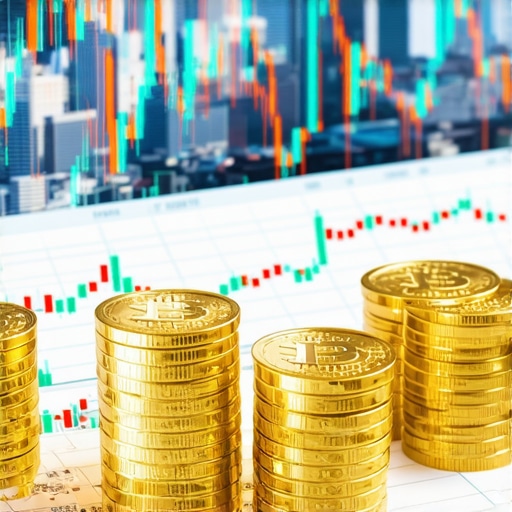The Impact of Central Bank Purchases on Gold Prices
Gold has been a safe haven for investors for centuries, often viewed as a reliable store of value during times of economic uncertainty. One of the key players in the gold market are central banks, which hold significant reserves of gold and can influence its price through their purchasing and selling activities. Understanding how central bank purchases affect gold prices is essential for investors looking to navigate the complexities of the gold market.
Why Do Central Banks Buy Gold?
Central banks buy gold for various reasons, primarily as a means of diversifying their reserves and stabilizing their national currency. In times of inflation or geopolitical instability, gold serves as a hedge that can preserve wealth. Countries such as Russia and China have significantly increased their gold reserves in recent years, reflecting a strategic move to decrease reliance on the US dollar and enhance financial security. This accumulation of gold not only impacts their national economies but also sends signals to the global market, often leading to price fluctuations.
The Dynamics of Gold Prices and Central Bank Purchases
When central banks announce their gold purchases, it can lead to immediate increases in gold prices. This is due to the basic economic principle of supply and demand; when demand increases from major players like central banks, it can create upward pressure on prices. Furthermore, large-scale purchases can often instill confidence in investors, leading to increased buying activity in the market. Conversely, if a central bank decides to sell off its gold reserves, it can lead to a decline in prices, as this may be interpreted as a lack of confidence in the asset.
Analyzing Central Bank Trends and Gold Prices
Investors should closely monitor central bank activities to anticipate potential changes in gold prices. Reports from institutions like the International Monetary Fund (IMF) provide valuable insights into the buying and selling trends of central banks. For example, a recent report indicated that central banks globally have been net buyers of gold in the past few years, driving demand and consequently influencing price stability. Keeping an eye on these trends can offer investors a strategic advantage in their investment decisions.
Conclusion: The Future of Gold Prices Amidst Central Bank Activities
In conclusion, central bank purchases play a pivotal role in shaping the dynamics of gold prices. As these institutions continue to accumulate gold, investors can expect increased volatility and opportunities within the gold market. Understanding the motivations behind central bank purchases and staying informed about their activities can help investors make more informed decisions regarding their gold investments. For those looking to delve deeper into investment strategies, exploring how gold can serve as a hedge in your investment portfolio is highly recommended.
The Importance of Gold in Your Diversified Investment Portfolio
As part of a well-rounded investment strategy, gold plays a crucial role in enhancing overall financial stability. Investors often seek to include gold in their portfolios as a hedge against inflation and economic downturns. This precious metal not only provides a sense of security but also serves as a strategic asset during volatile market conditions. Understanding the importance of gold in a diversified investment portfolio can greatly benefit both seasoned and novice investors.
The Value of Gold During Economic Downturns
Historically, gold has demonstrated its resilience during economic crises. When stock markets falter, investors flock to gold as a safe haven. This behavior is largely driven by gold’s intrinsic value; unlike fiat currencies, gold cannot be printed or devalued at will. Therefore, its worth tends to remain stable or even appreciate during turbulent times. By allocating a portion of their investments in gold, investors can safeguard their wealth against inflation and market volatility.
Gold as a Hedge Against Inflation
Inflation erodes the purchasing power of currency, making it essential for investors to seek assets that retain value. Gold has long been considered an effective hedge against inflation. When inflation rates rise, the value of gold tends to increase, providing a buffer for investors. This characteristic makes gold a vital component of any investment strategy aimed at preserving wealth over the long term. For those interested in mitigating inflation risks, exploring why investing in gold as a hedge against inflation is beneficial.
The Strategic Advantages of Gold Investing
Investing in gold offers several strategic advantages. Firstly, it provides portfolio diversification, reducing overall risk. Secondly, gold has a low correlation with other asset classes, meaning it often performs well when stock markets are down. This unique characteristic enables investors to achieve better risk-adjusted returns. Furthermore, gold investments can take various forms, including physical gold, gold ETFs, and gold mining stocks, allowing investors to choose the best option that aligns with their financial goals.
Understanding Gold Demand Trends for Future Investments
Monitoring gold demand trends is essential for investors who wish to capitalize on price fluctuations. Various factors influence gold demand, including central bank policies, geopolitical tensions, and changes in consumer behavior. For instance, the increasing demand for gold in emerging markets, particularly in Asia, presents unique investment opportunities. By staying informed about these trends, investors can make more educated decisions regarding their gold investments. For insights on this topic, consider reading understanding gold demand trends for future investments.
Conclusion: The Strategic Role of Gold in Investment Portfolios
In conclusion, gold’s role in an investment portfolio is multifaceted. It serves not only as a hedge against inflation and economic instability but also enhances overall diversification. Investors who recognize the value of including gold in their strategies can better position themselves to navigate market uncertainties. As you consider your investment options, remember the strategic benefits that gold can provide in securing your financial future.
Exploring Investment Strategies for Gold in 2025
As we approach 2025, it’s crucial for investors to explore effective strategies that capitalize on the evolving gold market. With fluctuating demand and unique economic factors at play, understanding how to tailor your gold investments can yield significant benefits. Whether you’re considering 2025’s best gold investment strategies or looking to adapt your existing portfolio, being informed is key to success.
Shifting Consumer Preferences in Gold Investments
Consumer preferences are shifting, heavily impacting gold demand. Millennials and Gen Z investors are increasingly interested in sustainable and ethical investments, which extends to gold. This trend is driving demand for responsibly sourced gold, influencing how companies operate and market their products. Investors should consider these factors when evaluating potential gold purchases. For a deeper dive into consumer behavior, explore safe investment tips in gold bullion.
Central Bank Policies and Their Impact on Gold Demand
Central banks play a pivotal role in shaping gold demand through their buying and selling strategies. In recent years, many central banks have increased their gold reserves as a hedge against economic uncertainty and inflation. This behavior not only stabilizes the gold market but also signals confidence in gold as a long-term investment. Understanding the implications of central bank policies can help investors make informed decisions regarding their gold holdings. For insights into how these policies influence prices, check out central bank purchases and gold price trends.
Emerging Markets Driving Gold Demand
Emerging markets, particularly in Asia, are becoming significant drivers of gold demand. Countries like India and China have seen a surge in gold consumption, primarily driven by cultural factors and increasing wealth. Investors should pay attention to these trends as they present lucrative opportunities in global gold markets. Engaging with the dynamics of emerging markets can provide investors with a competitive edge. To learn more about the influence of these markets, visit analyzing gold demand trends.
Technological Advancements in Gold Trading
Technological advancements are revolutionizing the way gold is traded. The rise of digital gold wallets and blockchain technology has made it easier for investors to buy, sell, and store gold securely. These innovations are not only enhancing the trading experience but also attracting a new generation of investors to the gold market. Keeping abreast of these developments can help investors leverage technology for better returns. For more information on effective trading methods, refer to essential gold trading tools.
Conclusion: Positioning Yourself for Future Gold Investments
As the gold market continues to evolve, positioning yourself strategically is essential for maximizing returns. By understanding the various factors influencing gold demand—such as consumer behavior, central bank policies, and technological advancements—investors can make informed decisions that align with market trends. Whether you’re a seasoned investor or just starting, incorporating these insights into your investment strategy will help ensure your success in the dynamic landscape of gold investments.
Understanding Gold Supply and Demand Dynamics
The interplay between gold supply and demand is fundamental to the market’s health and price stability. As demand from consumers and industries fluctuates, understanding these dynamics can significantly impact investment decisions. Factors such as mining output, recycling rates, and geopolitical events can alter supply levels. Investors should keep an eye on these elements and how they correlate with gold price movements. For insights into current trends, consider key takeaways on gold supply and demand trends.
The Role of Gold Mining Stocks in Your Portfolio
Investing in gold mining stocks can offer a different exposure to gold prices compared to direct gold ownership. These stocks can be affected by operational efficiency, management decisions, and market conditions, which makes them a more dynamic investment option. Understanding the risks associated with mining stocks, such as fluctuating operational costs and regulatory hurdles, is essential. For tips on selecting high-potential gold stocks, check out tips for selecting gold stocks.
Diversification: Balancing Gold Investments with Other Assets
Diversification is a critical strategy for managing investment risk. While gold can provide a hedge against inflation and economic downturns, it’s important to balance your investments with other asset classes. This approach can help cushion against market volatility. Investors should consider how gold fits into their broader investment portfolio, especially in uncertain economic climates. For a comprehensive guide on gold in diversified portfolios, visit the importance of gold in your diversified investment portfolio.
Evaluating Gold ETFs versus Physical Gold
When considering gold investments, one must choose between physical gold and gold exchange-traded funds (ETFs). Each option has its advantages and disadvantages. Physical gold offers tangible ownership but comes with storage and insurance costs, while gold ETFs provide liquidity and ease of trading without the need for physical storage. Understanding these trade-offs can guide investors in selecting the best option for their investment strategy. For a detailed comparison, explore physical gold vs. gold ETFs.
Conclusion: Preparing for a Successful Gold Investment Journey
As the gold market evolves, staying informed and adaptable is key to successful investments. By understanding the dynamics of supply and demand, exploring various investment vehicles, and diversifying your portfolio, you can position yourself effectively for the opportunities that lie ahead. Whether you’re eyeing gold mining stocks or contemplating gold ETFs, aligning your strategies with market trends will be crucial for maximizing returns in 2025.
Frequently Asked Questions About Gold Investments
What are the main factors driving gold prices?
The main factors influencing gold prices include supply and demand dynamics, geopolitical tensions, economic stability, inflation rates, and currency fluctuations. Understanding these elements can help investors anticipate market movements and make informed decisions.
How can I start investing in gold?
To start investing in gold, you can choose between physical gold (such as coins and bars), gold mining stocks, or gold ETFs. Each option has its advantages, so evaluate your investment goals, risk tolerance, and market conditions before making a choice.
Is investing in gold mining stocks riskier than physical gold?
Yes, investing in gold mining stocks carries additional risks compared to physical gold ownership. Mining stocks are influenced by operational performance, management decisions, and external market factors, while physical gold is a tangible asset that retains intrinsic value.
What percentage of my portfolio should be in gold?
Financial advisors often recommend allocating between 5% to 10% of your investment portfolio to gold. This percentage can vary based on your individual risk tolerance, investment strategy, and market conditions. It’s essential to consider gold’s role in your overall diversification strategy.
Are gold ETFs a good investment?
Gold ETFs are a popular investment option due to their liquidity and ease of trading. They allow investors to gain exposure to gold prices without the need for physical storage. However, they may not offer the same level of security as holding physical gold. Assess your needs and preferences before choosing this route.
How do geopolitical events affect gold prices?
Geopolitical events, such as wars, political instability, and economic sanctions, can lead to increased uncertainty in financial markets. As a result, investors often turn to gold as a safe haven, driving up its prices during turbulent times.
Is gold a good hedge against inflation?
Yes, gold is traditionally viewed as a hedge against inflation. As the purchasing power of currency declines, gold tends to retain its value, which can protect investors’ wealth during inflationary periods.
What are the risks of investing in physical gold?
Investing in physical gold comes with certain risks, including storage costs, insurance expenses, and potential theft. Additionally, the market for physical gold can be less liquid than that of gold ETFs or mining stocks, making it essential to weigh these factors when considering this investment.
Authority Resources for Gold Investment
For further insights and expert opinions on gold investment, consider exploring these trusted resources:
- World Gold Council – An authoritative source of information about gold market trends and insights.
- Investing.com – Offers comprehensive financial news, analysis, and data related to gold and other investments.
- Kitco News – A leading provider of precious metals market information, including live gold prices and analysis.
- Forbes – Features articles on investment strategies, including expert perspectives on gold and precious metals.
- MarketWatch – Provides insights into market trends, including gold price movements and economic indicators affecting gold investments.
Conclusion: Your Path to Successful Gold Investment
In conclusion, navigating the world of gold investments requires a deep understanding of market dynamics, a diversified approach, and a clear strategy aligned with your financial goals. By leveraging the insights provided in this guide, including key factors influencing gold prices, the different investment vehicles available, and how to incorporate gold into your portfolio, you can effectively position yourself for long-term success. Whether you opt for physical gold, mining stocks, or gold ETFs, staying informed and adaptable is essential in this ever-changing market. Invest wisely and may your gold investment journey bring you prosperity!











The role of central banks in influencing gold prices is indeed a fascinating aspect of the precious metals market. From my experience watching how geopolitical tensions and inflation fears affect markets, it’s clear that central bank gold purchases often act as a strong signal to investors—not just because of the direct impact on supply and demand, but also because it reflects broader economic confidence or caution. For instance, when countries like Russia or China ramp up their gold reserves, it seems to signal a strategic hedging against dollar dependency, which in turn shakes investor sentiment globally. However, I wonder how much of this effect is immediate versus gradual? Do central bank announcements tend to cause a short-term spike in gold prices, or can their sustained buying really shift long-term price trends? And relatedly, how much do you think investor psychology plays into this dynamic compared to the actual physical demand? It would be interesting to hear how other investors interpret central bank activities and whether they adjust their own portfolios based on these moves or focus more on broader economic indicators.
The post on how central bank purchases influence gold prices is quite insightful. From my perspective, the immediate spike in gold prices following an announcement is often driven by investor sentiment and fears about economic stability. However, I believe that the long-term impact depends more on whether these purchases reflect a sustained strategy or just short-term tactical moves by countries. For instance, countries like Russia and China increasing their reserves might signal a broader shift away from the US dollar, which could have lasting effects on gold’s role as a reserve asset. I’ve also noticed that investor psychology can sometimes amplify these moves—when markets see heavy buying, it triggers a feedback loop of buying, further boosting prices. Does anyone have experience with how the market reacts in the days or weeks following these central bank decisions? It seems like understanding the broader geopolitical context gives better clues than just the headline news.